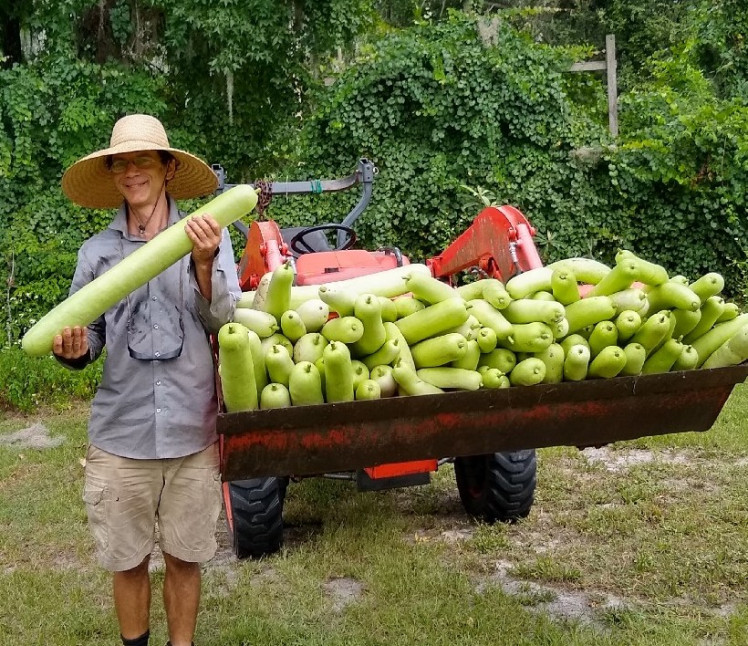My friend Craig Hepworth has written an excellent post on the edible uses of bottle gourd.
Did you know they were a good edible? I didn’t!
“Here in Florida, the months of June through September offer an ideal testing ground for how well vegetables can tolerate hot, steamy weather. Many common vegetables struggle in the sauna-like conditions, but we’re finding that Lageneria siceria produces food here all summer like a champion.
A member of the squash family, Lagenaria is an aggressively spreading vine, and is best grown on a trellis. Fruits harvested at the right stage for edibility have a mild, pleasant taste, intermediate between cucumber and zucchini/courgette.
The fruits are great cooked or raw. Reportedly they are extremely popular in Indian cooking. I’ve tried using the fruits in dishes – they cook rapidly, so I throw a bunch of chunks into a soup or pot of beans for the last few minutes of cooking, where they taste pleasant and filling.
Lagenaria fruits are great raw. They can be cut into veggie sticks, sliced into salads, or cut into “zoodles”, the raw vegetable noodles that have recently become popular as a tasty yet low calorie dish.
They’re also good raw. If you harvest them young enough, the skin is soft and edible. Left on the vine a little longer, the skin starts to toughen, and I find that it’s best to peel them. Sliced into veggie sticks, they are an ideal low-calorie snack to keep on hand in the refrigerator when you get an urge to nibble. They’re great mixed into a salad, and I have used them all on their own (with dressing) to make a cucumber salad. You can also use Lagenaria fruits to make excellent “zoodles”, the raw zucchini noodles that have become popular as a low-calorie main course for the health conscious.
If you let Lagenaria fruits stay on the vine past the edible stage, they develop a hard shell, and eventually dry out into a hollow gourd that can be used as a container. Some of the common names for the species reflect this usage, like bottle gourd, bird house gourd, and calabash (not to be confused with the calabash tree, Crescentia cujete, which also makes hard-shelled fruits that are used for containers).
There are numerous breeds of Lagenaria, with varying shapes…”
Craig is a brilliant plant guy. He’s the one that first introduced me to the incredible value of D. alata as a staple crop in Florida. If you’re not following his blog or Instagram account, I recommend you do so.


3 comments
Hi David, thanks for kind words and repost. Interestingly, since I made that post, a number of people have messaged me about how this plant is a beloved traditional food in India, Vietnam, and the Philippines. I also got a couple reports that stink bugs can sometimes be a problem with this species in FL, although the plantings I observed of it were unbothered by that pest.
You bet. I only tried growing them once and they succumbed to powdery mildew, but I didn’t try seriously. It was more of a “toss a few seeds in a corner” attempt. I will have to try again. When I first saw your picture I thought they were wax gourds, as I’ve seen the Chinese growing those locally. Very similar.
[…] post Bottle Gourd Edible? appeared first on The Survival […]
Comments are closed.